Calm on the outside, agitated on the inside. Does this sound like you? How is that for you? Is it working in your favour? Or is there something you’d like to change?

Picture This

I’d like to invite you to picture yourself relaxed and at ease sipping a cool drink as you gaze out at the rugged mountains and the ancient valleys that surround you. A gentle breeze reminds you of the changing seasons. Thinking towards your future, your confidence rises. Your calm demeanour is a reflection of genuinely feeling calm on the inside. You’ve gained clarity about your dreams and goals, and you’ve tapped into your inner strengths. In the company of like-minded women, you’ve acknowledged the challenges that have held you back. The time for change has come. You’re ready to do things differently, to make self-care a priority, to celebrate who you are, and to take actions that align with your values and purpose.
With a clear plan for working towards your personal goals, you know just what you need to do. You no longer waste your energy stressing over things you can’t change. As you focus more and more on those things you have control over, your circle of influence expands. As you become increasingly inspired by your dream, so too you inspire others around you. Despite the inevitable challenges, you stand grounded in confidence knowing that you’re never alone, that you have the inner and outer resources to maintain your momentum.
Does this sound like you? Or perhaps something you’d like to experience in life?
Inner self, outer appearances
No matter how you appear to others, you are the only one that truly knows your inner turmoil, struggles, challenges, and disappointments. You might go through the motions of being a high functioning worker, mother and partner, but inside you could be experiencing agitation or distress. Lost dreams, worries, a lack of fulfilment – these are just some of the experiences women often keep to themselves. Stewing away inside they create a hot bubbly mess that has us feeling bitter and helpless. But still, we push on. Not happy or content. But we keep on going.
What if I told you it doesn’t have to be this way?
It’s true ….. it doesn’t have to be this way. I know. I’ve been there. Several times. I’ve also walked alongside many women who’ve experienced something similar themselves. We all have a different story, different experiences, but there are also many common threads. By sharing these threads, we get to weave a new story. A more powerful story that builds us up, that empowers us, instead of depleting us.
Companionship, community and connection are key factors
Companionship and community are two of the keys to writing a new story. When we’re very isolated from others we have difficulty thriving. Looking back I can clearly see the turning points in my own life when I connected with the people who became my tribe. I’ve had a couple of very special relationships with other women who truly ‘got me’. They accepted me just as I was. They lifted me up and showed me there’s more to life than the narrow window I’d been looking through. They demonstrated assertiveness and values-based action. They were friends and mentors who have had a profound impact on how I saw myself.
In recent years I’ve also had the privilege of being part of a community of women who openly encourage, inspire, embrace, love and connect with each other in incredibly meaningful ways. This tribe of women reflects many of the values so important to me – independence, connection, innovation, peace, creativity, courage, companionship, community. They’ve taught me that I am enough. Just me. The way I am. No labels. No definitions. No limitations. And that’s given me the space to be even more than I ever thought I was or could be.
I’m still an introvert, I still love my time alone. But now it’s not lonely alone-time. I am deeply connected with others and I’m part of a tribe. We don’t desperately need to be with each other all the time. But the fact that we know we’re a stand for each other, that we’re part of a supportive community, makes each of us stronger and enables us to make a difference in our worlds – both inner and outer.
Women Empowered Retreats

This is my philosophy behind the Women Empowered Retreats. I know the benefits of connecting women together in deep, rich, meaningful conversation. I know the power of sharing stories in safe spaces. The power of connection and community. The power of knowledge and information sharing. The difference that inspiration makes to our sense of happiness, contentment, and fulfilment. The feeling of being calm on the inside, not just looking calm on the outside.
Every woman is drawn to our retreats for different reasons and will have a different experience from anyone else. Each retreat explores a different theme that weaves together elements of personal growth. But at each retreat we come with an open mind. We seek to be informed, inspired and empowered to be ourselves. We offer a gentle balance of information sessions, reflective activities, mindfulness practices, creative arts, movement, nature, and soul-nourishing food.
Whether you are simply looking for time and space to recharge, or if you are looking for a deeper meaning in your life, you will be inspired and empowered to live the life you love.
An invitation to discover calm on the inside
If this sounds like a slice of heaven to you, then we’d love you to join us for any of our upcoming retreats. This could be the beginning of your journey to discover what it feels like to be calm on the inside, or perhaps it’s an opportunity to connect with a community who will inspire you as you take action towards your dreams. Whether you’re a local or a visitor to the region, whether you come alone or with a friend, you’ll be joining a strong, growing community of women who know the value of self-care, personal growth, and connection with others.
Our upcoming “Women Empowered’ events include:

Friday 26th July 2019 during the Jumpers and Jazz in July Festival
(PHOTO CREDIT: Darling Downs Wellness Therapies)
- Hike Your Mountain (June 2019)
- Yarn and Yoga in the Country (July 2019)
- Women’s Health Retreat (September 2019)
- Spring Retreat (October 2019)
To keep up to date with details as they are released, subscribe to my emails via my website and follow me on Facebook.

Discovering mountain biking as life’s ultimate parallel universe in her middle age, Kathryn Walton shares information and reflections in ‘Daisy Spoke’ that inform, inspire and empower women to a healthy and active lifestyle.




 The way we think is closely related to the way we have been socialised when were younger, with the added layer of personality thrown in. So it’s no surprise that women often share certain beliefs, assumptions and thinking patterns related to self-care – it’s selfish to do something for myself; people will think I’m selfish / not coping; time and money should be spent on something or someone else who needs it more than me; I don’t have enough time or energy; I should just soldier on like everyone else does …..
The way we think is closely related to the way we have been socialised when were younger, with the added layer of personality thrown in. So it’s no surprise that women often share certain beliefs, assumptions and thinking patterns related to self-care – it’s selfish to do something for myself; people will think I’m selfish / not coping; time and money should be spent on something or someone else who needs it more than me; I don’t have enough time or energy; I should just soldier on like everyone else does …..

 So first of all, make sure you GET THE BIG ROCKS IN YOUR LIFE FIRST. They are your priorities so take steps to make sure you allow plenty of time and energy for them. Next put in your medium-sized rocks. Your small rocks go in after that and will be able to settle into the spaces between the bigger rocks. You can be more flexible with how they fit into your life. Next comes the sand. These things will be able to flow into the spaces that you have left. If there isn’t time and energy for them right now, that doesn’t matter. When things settle, they’ll have a place in your bucket once again.
So first of all, make sure you GET THE BIG ROCKS IN YOUR LIFE FIRST. They are your priorities so take steps to make sure you allow plenty of time and energy for them. Next put in your medium-sized rocks. Your small rocks go in after that and will be able to settle into the spaces between the bigger rocks. You can be more flexible with how they fit into your life. Next comes the sand. These things will be able to flow into the spaces that you have left. If there isn’t time and energy for them right now, that doesn’t matter. When things settle, they’ll have a place in your bucket once again. 



 was missing it.
was missing it. 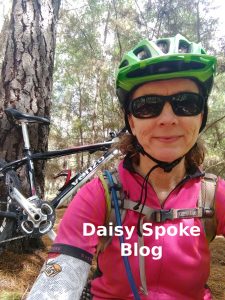 I’ve been practising and teaching this technique for a lot of years, and yet still I sometimes forget to do it when the moment arises. The thing is that on Sunday morning I DID NOTICE those fearful thoughts bouncing round my head. And guess what?
I’ve been practising and teaching this technique for a lot of years, and yet still I sometimes forget to do it when the moment arises. The thing is that on Sunday morning I DID NOTICE those fearful thoughts bouncing round my head. And guess what?  of short hills engaging my quads in an exertion that a couple of years ago would have been painful (if not impossible)! I pedalled in a higher gear than normal and found it easier than expected.
of short hills engaging my quads in an exertion that a couple of years ago would have been painful (if not impossible)! I pedalled in a higher gear than normal and found it easier than expected. 
 before we even set up camp we had a short walk around the area. A sudden loud rustle in the bushes next to us startled me. Turning around and expecting to see a wallaby, my daughter tells me I wouldn’t want to know what made that noise. On further enquiry she tells me it was a rather large snake, and I began to seriously wonder about moving our campsite further away from said snake.
before we even set up camp we had a short walk around the area. A sudden loud rustle in the bushes next to us startled me. Turning around and expecting to see a wallaby, my daughter tells me I wouldn’t want to know what made that noise. On further enquiry she tells me it was a rather large snake, and I began to seriously wonder about moving our campsite further away from said snake. My uneasiness only increased as the evening rolled on and in particular when we came face to face with another snake only a few metres from our tents. Still, I wandered why the uneasiness was there in the first place. Was I sensing a spiritual presence? Was it simply that everything seemed strange and unfamiliar? Or perhaps the absence of other humans? Was I simply tired and misreading my intuition? Was it FEAR welling up and testing my inner strength?
My uneasiness only increased as the evening rolled on and in particular when we came face to face with another snake only a few metres from our tents. Still, I wandered why the uneasiness was there in the first place. Was I sensing a spiritual presence? Was it simply that everything seemed strange and unfamiliar? Or perhaps the absence of other humans? Was I simply tired and misreading my intuition? Was it FEAR welling up and testing my inner strength?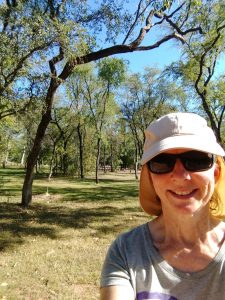 And so I survived. In fact I thrived and had possibly the best sleep so far on my April Adventure. I awoke before dawn, spent a couple of hours silently meditating, embracing my surroundings and feeling entirely captivated by what seemed so haunting and difficult the day before. I feel an immense sense of satisfaction that I didn’t allow my anxiety to rule and limit me. I chose to respect it but also to stand up to it. In doing so I’ve come to know an amazing spiritual aspect of this sacred land which I may not ever understand, but I can accept it and embrace it. And when I do that, I also accept and embrace myself.
And so I survived. In fact I thrived and had possibly the best sleep so far on my April Adventure. I awoke before dawn, spent a couple of hours silently meditating, embracing my surroundings and feeling entirely captivated by what seemed so haunting and difficult the day before. I feel an immense sense of satisfaction that I didn’t allow my anxiety to rule and limit me. I chose to respect it but also to stand up to it. In doing so I’ve come to know an amazing spiritual aspect of this sacred land which I may not ever understand, but I can accept it and embrace it. And when I do that, I also accept and embrace myself.


 Donna Neale-Arnold was my co-facilitator and special advisor at our recent retreat. She shared her w
Donna Neale-Arnold was my co-facilitator and special advisor at our recent retreat. She shared her w
 Daily exercise and general physical activity are crucial elements of feeling good. Just as some people might need to diligently take medication every day, I need to exercise every day. Exercise is nature’s way of stimulating the hormones which aid concentration, problem-solving, sleep, digestion, and mood. This daily dose of exercise rebalances our body’s systems resulting in wide-ranging benefits that no single medication can provide. The research is absolutely clear that regular medium to high intensity exercise can have a profound effect on health AND happiness.
Daily exercise and general physical activity are crucial elements of feeling good. Just as some people might need to diligently take medication every day, I need to exercise every day. Exercise is nature’s way of stimulating the hormones which aid concentration, problem-solving, sleep, digestion, and mood. This daily dose of exercise rebalances our body’s systems resulting in wide-ranging benefits that no single medication can provide. The research is absolutely clear that regular medium to high intensity exercise can have a profound effect on health AND happiness.
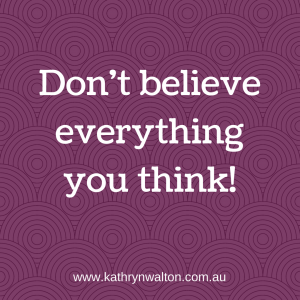 Minds are such complex things! They wield a lot of power over our emotions and our actions (including sleep). But unless you notice what’s going on in your mind, and choose how much power to give it, your thoughts, assumptions and beliefs will control you instead of the other way around. The habit of being hooked by thoughts or strongly attached to them is limiting and anxiety-provoking. The key here is to begin by simply noticing what is happening in your mind, and by doing this with curiosity and without judgement. The power is in the noticing. You’ll collect all sorts of interesting bits of information about how your mind works, what thinking patterns it gets locked into, what beliefs and assumptions are behind it all, and how all of this impacts your physiology, your behaviours and your emotions. One of my favourite sayings is “Don’t believe everything you think!” because we can learn to stand back, notice the thought and choose whether to believe it, or not.
Minds are such complex things! They wield a lot of power over our emotions and our actions (including sleep). But unless you notice what’s going on in your mind, and choose how much power to give it, your thoughts, assumptions and beliefs will control you instead of the other way around. The habit of being hooked by thoughts or strongly attached to them is limiting and anxiety-provoking. The key here is to begin by simply noticing what is happening in your mind, and by doing this with curiosity and without judgement. The power is in the noticing. You’ll collect all sorts of interesting bits of information about how your mind works, what thinking patterns it gets locked into, what beliefs and assumptions are behind it all, and how all of this impacts your physiology, your behaviours and your emotions. One of my favourite sayings is “Don’t believe everything you think!” because we can learn to stand back, notice the thought and choose whether to believe it, or not.
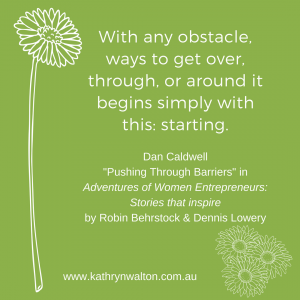
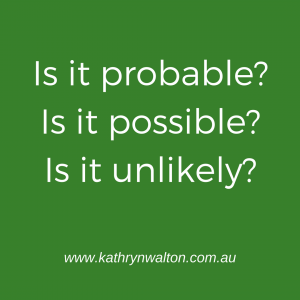



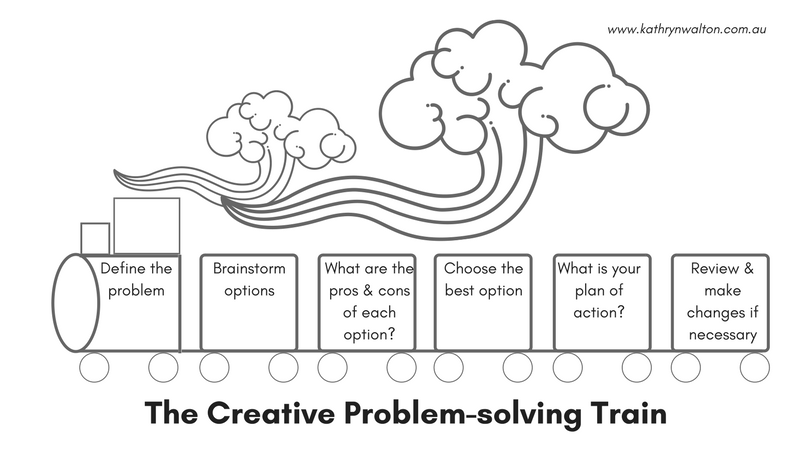
 analysing
analysing 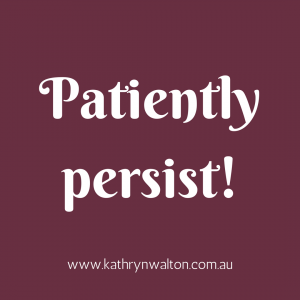 more time? More resources?
more time? More resources?